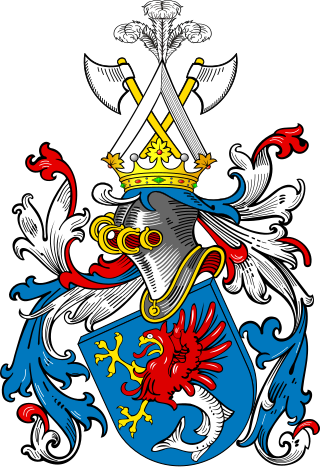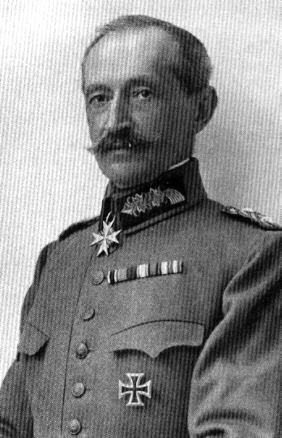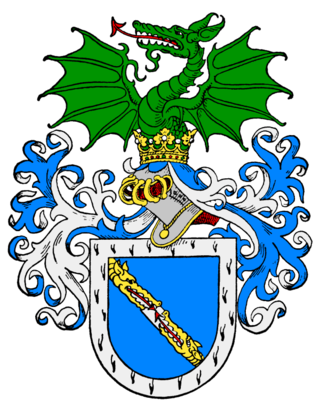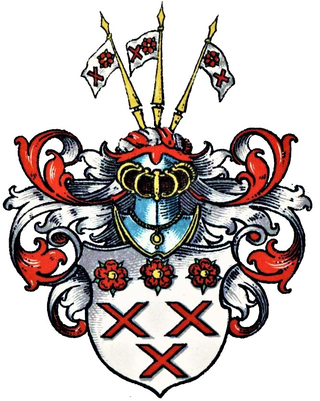
Arenstorff, also Arnstorff, is the name of a German family in the ancient nobility of Brandenburg from the Uckermark.

Arenstorff, also Arnstorff, is the name of a German family in the ancient nobility of Brandenburg from the Uckermark.
The family appeared for the first time in the records on 29 September 1306 with Ludolf de Arndesdorp [1] , with whom the main line also began. The clan obtained the naturalization into the nobility of Denmark on 24 April 1670 for Friedrich von Arensdorff, who later became the commanding General in the Royal Danish Army, councilor and the Governor of Schleswig and Holstein.
In the Einschreibebuch [Book of Registers] of the Dobbertin Abbey, there are 13 entries for the daughters of the A(h)renstorff family for the years between 1723 and 1910 from Krümmel (Lärz), Sadelkow and Oyle in the Grafschaft [County of] Hoja for the admission into the noble community at the Dobbertin Abbey.
In Blue 3 (2.1) silver lilies, accompanied by silver portcullises, six growing out of the top edge on the sides and three from the bottom edge of the shield. On the helmet with a blue and silver mantle, from a five-piece portcullis, arises a gold-crowned natural bear with a collar.

Taczanowski is the surname of a Polish szlachta (nobility) family from Poznań bearing the Jastrzębiec coat of arms and the motto: Plus penser que dire. They took their name from their estate Taczanów in the 15th century and by the 19th century were among the leading magnates in partitioned-Poland. Members of the family are historically significant religious, political, scientific, and military figures. The family was granted the title of count by King Friedrich Wilhelm IV of Prussia in 1857. The Austrian branch of the family, which spells the name Dassanowsky, came to Vienna with the forces of King Jan Sobieski during the Battle of Vienna in 1683.

Georg Wilhelm von Siemens was a German telecommunications industrialist of the Siemens family.
Thienen is the name of an ancient noble family, that origins in the Duchy of Holstein. The spelling of the name, over the centuries has changed from Tyne and Tynen to Thien, Tienen, Thinen and finally Thienen. The barons of Thienen-Adlerflycht are the only branch of this family still existing; they belong to the high nobility of Denmark.

The House of Puttkamer belongs to a widely extended German noble family whose earliest ancestor is first recorded between 1257 and 1260 in Schlawe (Sławno), Farther Pomerania. While some of its branches have the title of Graf (count), others are entitled to the lesser Freiherr (baron). According to a widespread family tradition, many firstborn Puttkamer sons receive the first name of "Jesco". The branch of the family moved in the 16th century to Livonia and from there to the Polish-Lithuanian Commonwealth.

The House of Finck von Finckenstein is a noble family classified as Uradel. It is one of the oldest Prussian aristocratic families extant, dating back to the 12th century in the Duchy of Carinthia.

Hugo Karl Gottlieb von Kathen was a German infantry general during World War I.

The House of Galen is an ancient and influential German noble, Westphalian family, historically Roman Catholic, from the County of Mark.

The House of Hoyos is a Spanish and Austrian noble family. It derives its name from El Hoyo de Pinares in Ávila, Castile and León, and can be traced to the 9th century.

Joseph Freiherr von Spaun was an Austrian nobleman, an Imperial and Royal Councillor, lottery director, and honorary citizen of Vienna and Cieszyn. He is best known for his friendship with the composer Franz Schubert.

Ferdinand Miller, from 1875 von Miller and from 1912 Freiherr von Miller was an ore caster, sculptor and director of the Academy of Fine Arts, Munich. He also held a seat in the Royal Bavarian House of Lords, the Reichsrat.
Friedrich Hermann Julius Axel von Harnack was a German librarian, historian and philologist. He was the cousin of Arvid and Falk Harnack and worked to get Arvid and his wife, Mildred Harnack released from Nazi detention after they were arrested in connection with the Red Orchestra. He was the first in the family to be told of Arvid and Mildred's arrest, which had been kept secret by the Nazis. In 1947, he published a memoir of the trial that convicted Arvid and Mildred Harnack of high treason and sentenced them to death.

Hermann Christlieb Matthäus Stein, from 1913 von Stein was a Prussian officer, General of the Artillery and Minister of War during World War I. He was a recipient of Pour le Mérite.

The House of Moltke is the name of an old German noble family. The family was originally from Mecklenburg, but apart from Germany, some of the family branches also resided throughout Scandinavia. Members of the family have been noted as statesmen, high-ranking military officers and major landowners in Denmark and Prussia.

Merveldt is the name of a Westphalian noble family, which belongs to the nobility of the Middle Ages. The Herrn [Lords] von Merveldt were among the oldest families in the Münsterland. Merfeld, the eponymous seat of the family, is now a neighborhood of the city of Dülmen in the District of Coesfeld in the state of North Rhine-Westphalia in Germany.
Schirach or Šěrach is a noble family of Sorbian origin. Many family members were noted as theologians, lawyers, historians, writers and artists from the 17th century, and several family members have also been noted for their efforts to preserve the Sorbian language. The family was raised to the hereditary Austrian nobility in 1776. Family members are resident in Germany and, since the 19th century, the United States.

Dincklage is the name of a German family of Westphalian ancient nobility from Dinklage near Vechta, Lower Saxony. There are currently still two lines of the family: the Campe line and the Schulenburg line. The family is first attested 1231 with Johannes de Thinclage. The males of the family carry the title Baron or Freiherr.

Verschuer is a Dutch noble family originally from Appelrebroeck near Barneveld in Gelderland. The family has branches in The Netherlands and Germany. The family name is spelled van Verschuer in Dutch and von Verschuer in German.
Carl Baily Norris von Schirach was a German-American theatre director. He was head of the Weimar Court Theatre from 1909 to 1918. He was also a chamberlain at the grand ducal court in the Grand Duchy of Saxony, and was a retired captain of the cavalry (Rittmeister).

Georg Adolf Carl von Opel, known as Georg Adolf Carl Opel before being ennobled in 1918, was a bank specialist and industrialist of the Opel family and one of the founders of the German automobile manufacturer Opel.

The House of Poschinger is an ancient Bavarian noble family. It traces its origins back to 1140. The family received the rank of Knights of the Holy Roman Empire. The Frauenau branch rose to the rank of Barons (Freiherr) in the Kingdom of Bavaria and held a hereditary seat in the House of Councillors.